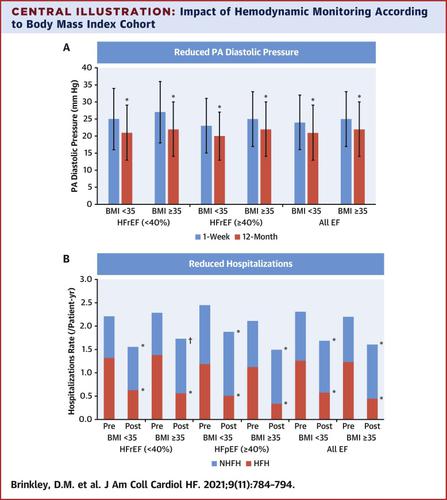JACC: Heart Failure ( IF 13.0 ) Pub Date : 2021-09-08 , DOI: 10.1016/j.jchf.2021.05.020 D Marshall Brinkley 1 , Maya E Guglin 2 , Mosi K Bennett 3 , Margaret M Redfield 4 , William T Abraham 5 , Marie-Elena Brett 6 , Nicholas Dirckx 6 , Philip B Adamson 6 , Lynne W Stevenson 1

|
Objectives
This study sought to determine the impact of therapy guided by pulmonary artery (PA) pressure monitoring in patients with heart failure (HF) and obesity.
Background
Obesity is prevalent in HF and associated with volume retention, but it complicates clinical assessment of congestion.
Methods
The CardioMEMS Post Approval Study was a prospective, multicenter, open-label trial in 1,200 patients with New York Heart Association functional class III HF and prior HF hospitalization (HFH) within 12 months. Patients with a body mass index (BMI) >35 kg/m2 were required to have a chest circumference <65 inches. Therapy was guided by PA pressure monitoring at sites, and HFHs were adjudicated 1 year before implantation and throughout follow-up. This analysis stratified patients according to ejection fraction (EF) <40% or ≥40% and by BMI <35 kg/m2 or ≥35 kg/m2.
Results
Baseline PA diastolic pressure was higher in patients with BMI ≥35 kg/m2 regardless of EF, but all PA pressures were reduced at 12 months in each cohort (P < 0.0001). HFH rate was reduced by >50% in both cohorts for EF <40% (BMI <35 kg/m2 [HR: 0.48; 95% CI: 0.41-0.55] and ≥35 kg/m2 [HR: 0.40; 95% CI: 0.31-0.53]) and EF ≥40% (BMI <35 kg/m2 [HR: 0.42; 95% CI: 0.35-0.52] and ≥35 kg/m2 [HR: 0.34; 95% CI: 0.25-0.45]; P < 0.0001). There was a nonsignificant trend toward greater reduction with more obesity. The all-cause hospitalization rate was also significantly reduced during monitoring (P < 0.01).
Conclusions
Management guided by PA pressure monitoring effectively reduced pressures, HFH, and all-cause hospitalization in patients with obesity regardless of EF. (CardioMEMS HF System Post Approval Study; NCT02279888)
中文翻译:

肺动脉压监测有效指导管理以减少肥胖患者的心力衰竭住院治疗
目标
本研究旨在确定肺动脉 (PA) 压力监测指导的治疗对心力衰竭 (HF) 和肥胖患者的影响。
背景
肥胖在 HF 中很普遍,并且与容量保留有关,但它使充血的临床评估复杂化。
方法
CardioMEMS 批准后研究是一项前瞻性、多中心、开放标签试验,在 1200 名纽约心脏协会功能性 III 级 HF 患者中进行了 12 个月内既往 HF 住院治疗 (HFH)。体重指数 (BMI) > 35 kg/m 2 的患者要求胸围 <65 英寸。治疗由现场 PA 压力监测指导,在植入前 1 年和整个随访期间裁定 HFH。该分析根据射血分数 (EF) <40% 或≥40% 和 BMI <35 kg/m 2或≥35 kg/m 2对患者进行分层。
结果
无论EF如何,BMI≥35 kg/m 2 的患者基线PA舒张压较高,但每个队列的所有PA压力在12个月时均降低(P < 0.0001)。对于 EF <40%(BMI <35 kg/m 2 [HR:0.48;95% CI:0.41-0.55] 和 ≥35 kg/m 2 [HR:0.40;95 % CI:0.31-0.53])和 EF ≥40%(BMI <35 kg/m 2 [HR:0.42;95% CI:0.35-0.52] 和 ≥35 kg/m 2 [HR:0.34;95% CI: 0.25-0.45];P < 0.0001)。随着肥胖程度的增加,没有显着减少的趋势。监测期间全因住院率也显着降低(P < 0.01)。
结论
无论EF如何,由PA压力监测指导的管理有效地降低了肥胖患者的压力、HFH和全因住院。(CardioMEMS HF 系统批准后研究;NCT02279888)



























 京公网安备 11010802027423号
京公网安备 11010802027423号